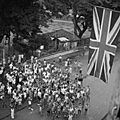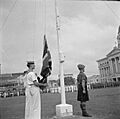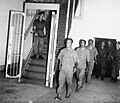Operation Tiderace facts for kids
Quick facts for kids Operation Tiderace |
|||||||
|---|---|---|---|---|---|---|---|
| Part of World War II | |||||||
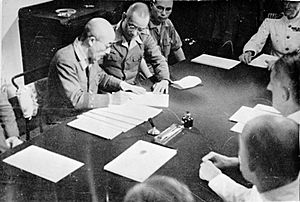 General Seishirō Itagaki signing the terms for the reoccupation of Singapore on board the heavy cruiser HMS Sussex. 4 September 1945 |
|||||||
|
|||||||
| Belligerents | |||||||
| Commanders and leaders | |||||||
| Strength | |||||||
| 77,000 infantry 2 heavy cruisers 1 destroyer 2 submarines |
60,000 infantry 7 escort carriers 2 battleships 1 heavy cruiser 2 light cruisers 15 destroyers 3 Royal Fleet Auxiliary 3 hospital ships 14 merchant vessels 43 landing ship, infantry |
||||||
| Casualties and losses | |||||||
| 300 ... 76,700 captured |
1 battleship damaged | ||||||
Operation Tiderace was the secret name for the British plan to take back Singapore after Japan surrendered in World War II in 1945. This important mission was led by Lord Louis Mountbatten, who was the top Allied commander in Southeast Asia. Operation Tiderace worked together with Operation Zipper, which was about freeing Malaya.
Planning the Return to Singapore
Why the Allies Planned to Invade Malaya
Before Japan surrendered, the Allies were making big plans to invade Malaya. This plan was called Operation Zipper. It involved over 100,000 Allied soldiers. The goal was to capture important ports like Port Swettenham and Port Dickson. More than 500 Royal Air Force planes were ready to help with airstrikes.
This attack was set for September 9, 1945. However, Japan surrendered on August 15, 1945, which changed everything. After securing these ports, the Allies planned to start Operation Mailfist. This would involve ground forces moving south through Malaya to free Singapore. This part was expected to happen between December 1945 and March 1946.
Emergency Plans for Singapore
Operation Tiderace was planned very quickly. This happened right after the Atomic bombings of Hiroshima and Nagasaki on August 6 and 9. The Allies needed to be ready to take over Singapore fast. This would happen if Japan agreed to the terms of the Potsdam Declaration from July 26.
Operation Zipper still happened, but it was much smaller. Many of its forces were quickly moved to Operation Tiderace instead.
The Allied Fleet for Tiderace
The group of ships for Operation Tiderace had about 90 vessels. This included two powerful battleships: HMS Nelson and the French battleship Richelieu. The heavy cruiser HMS Sussex was the main ship for the commander. HMAS Hawkesbury was the only Australian warship. It helped escort a ship carrying people back home.
A smaller British naval force was sent to free Penang. This mission was called Operation Jurist. It was part of the larger Operation Zipper.
There were also seven escort carriers in the fleet. These included HMS Ameer, HMS Attacker, HMS Emperor, HMS Empress, HMS Hunter, HMS Khedive and HMS Stalker'.
Japanese Forces in Singapore
The Japanese navy in Singapore had the destroyer Kamikaze. They also had two cruisers, Myōkō and Takao. These cruisers were badly damaged and were used as floating anti-aircraft batteries.
Two former German submarines, I-501 and I-502, were also in Singapore. They were docked at the Singapore Naval Base. The Japanese had about 170 aircraft in Malaya and Sumatra.
The Allies Return to Singapore
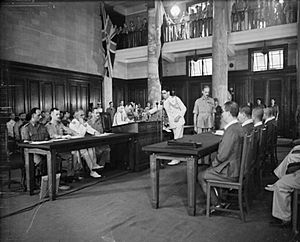
Operation Tiderace began on August 31. Mountbatten ordered Allied troops to sail from Trincomalee and Rangoon towards Singapore. The fleet did not carry many offensive weapons. Mountbatten believed the Japanese in Malaya and Singapore would surrender without a fight. On August 20, General Itagaki Seishiro, the Japanese commander in Singapore, had told Mountbatten he would follow his emperor's decision. He was ready to receive instructions for Singapore's surrender.
Japanese Reaction to Surrender News
Japan's defeat surprised the Japanese commanders in Singapore. Many did not want to surrender and wanted to fight until the end. General Itagaki first refused the surrender order. He told the 25th Army, which defended Singapore, to fight when the Allies arrived. There was even a secret plan to harm all Allied prisoners of war on the island.
However, three days after the Emperor's announcement on August 15, Itagaki flew to Saigon. He met with Field Marshal Count Hisaichi Terauchi, the top Japanese commander in Southeast Asia. Terauchi convinced Itagaki to surrender. After this, Itagaki sent his message to Mountbatten. Newspapers in Singapore were finally allowed to print the Emperor's speech. This confirmed what many people already knew from listening to All India Radio on forbidden shortwave radios.
Allied Arrival in Singapore
The Allies reached Malaya on August 28. A small part of the fleet went to recapture Penang as part of Operation Jurist. On August 30, nine RAAF Catalinas landed in Singapore. They brought medical supplies and documents. This was to prepare for the Japanese surrender and to help the thousands of prisoners of war.
Penang surrendered without a fight under Operation Jurist. The Allied fleet then sailed for Singapore on September 2. They passed the Raffles Lighthouse at the southern entrance to the Straits of Malacca. The fleet arrived in Singapore on September 4, 1945, and faced no resistance. However, the French battleship Richelieu hit a magnetic mine on September 9. It was passing through the Straits of Malacca. The ship slowly made its way into Singapore by September 11.
The Formal Surrender
General Itagaki, along with Vice Admiral Shigeru Fukudome and their helpers, came aboard HMS Sussex. This happened in Keppel Harbour to discuss the surrender. Lieutenant-General Sir Philip Christison and Major-General Robert Mansergh met them. A tense moment happened when a Japanese officer said, "You are two hours late." The reply was, "We don't keep Tokyo time here." By 6:00 PM, the Japanese had surrendered their forces on the island. About 77,000 Japanese troops from Singapore were captured. Another 26,000 from Malaya were also captured.
The formal surrender was completed on September 12 at Singapore City Hall. Lord Louis Mountbatten came to Singapore for this event. He received the formal surrender of Japanese forces in Southeast Asia from General Itagaki. Itagaki signed on behalf of Field Marshal Hisaichi Terauchi, who was the commander of the Japanese Southern Army Group. Terauchi had suffered a stroke earlier that year. A British Military Administration was set up to govern the island until March 1946. Itagaki later faced trial for his actions during the war.
Japanese Soldiers' Reactions
General Itagaki met his generals and senior staff at his headquarters. He told them they had to obey the surrender orders and keep the peace. Many Japanese soldiers found it very difficult to accept defeat.
About 200 Japanese soldiers decided to join communist fighters. These were the same people they had been fighting just days before. They hoped to keep fighting against the British. But they soon went back to their units. They found out that the communist group did not plan to fight the returning British.
Still, some Japanese soldiers stayed hidden in the jungles with the communists. In 1989, when the communist struggle ended, two former Japanese soldiers came out of the jungle with the communists and surrendered.
Images for kids
-
Cheering schoolchildren welcome the return of the British Army on 5 September 1945
-
Abandoned Japanese Ki-45 Toryu fighters captured at Kallang Airfield
See also
- History of Singapore
- Japanese occupation of Singapore
- Hasuda Zenmei






